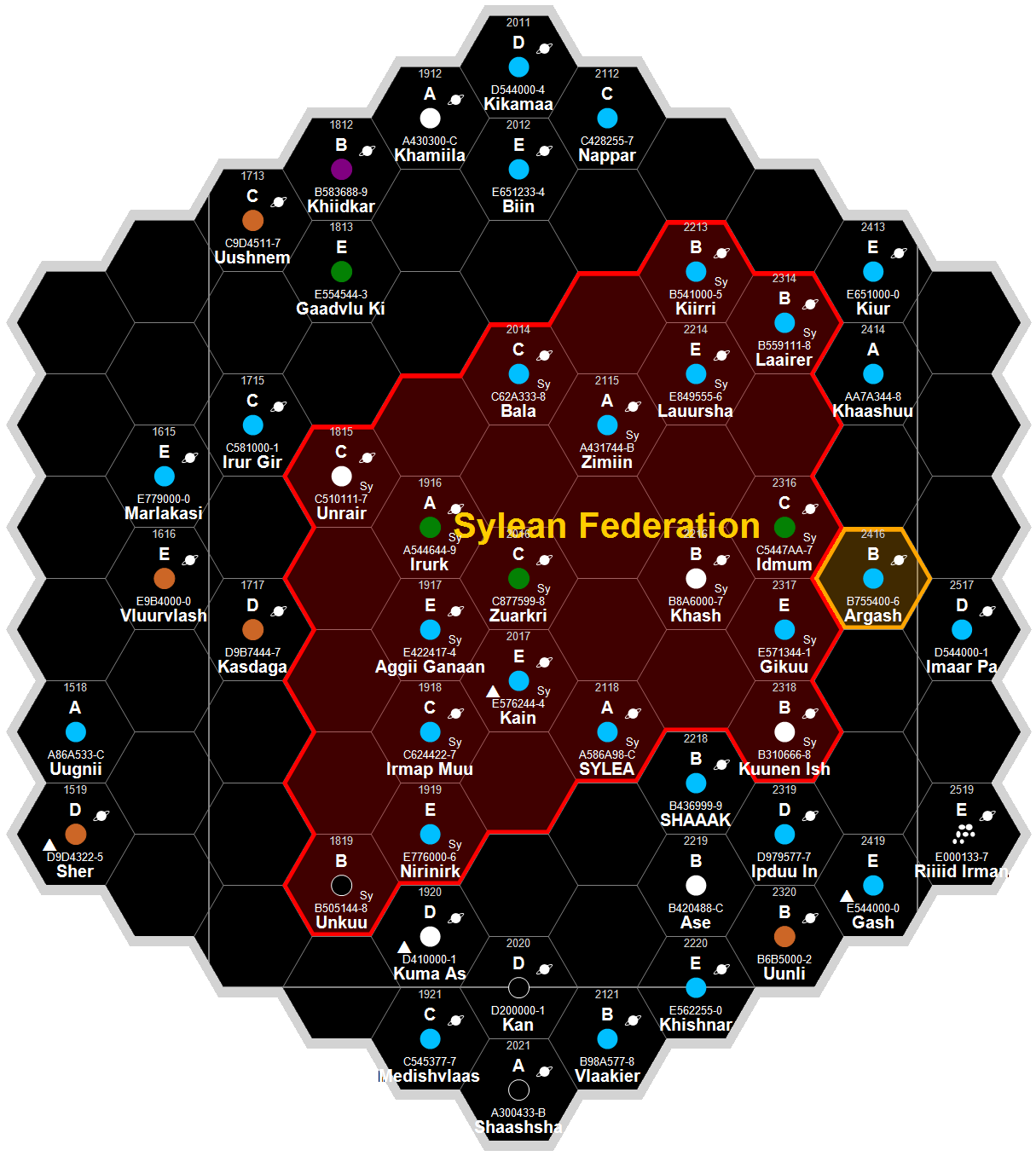Spinward Flow
SOC-14 1K
Long Night Tramp
Ship Type: AT (Merchant-A, Transport)
TL=10 (hybrid LBB5.80 design fitted with LBB2.81 commercial off the shelf standard drives) (LBB5.80, p18)
Tonnage (custom hull): 313 tons (MCr31.3) (LBB5.80, p21-22)
Configuration: 1 (Needle/Wedge, streamlined, MCr6.26) (LBB5.80, p21-23)
Armor: 0
Jump-E (code: 3, 30 tons, MCr50, TL=10, Civilian, Capacitor storage: 5 tons = 180 EP maximum)
Maneuver-E (code: 3, 9 tons, MCr20, TL=10)
Power Plant-E (code: 3, 16 tons, MCr40, TL=10, EP: 10, Surplus EP: +2.8 @ Agility 2, Emergency Agility: 3)
Total Drives: 30+9+16 = 55 tons (+8 tons Laser Fighter = 63 tons total)
Fuel: 124 tons = 93.9+30.1 tons (LBB2.81, p14-15, 23)
Fuel Purification Plant: 200 tons capacity (8 tons, MCr0.036, TL=10) (LBB5.80, p27, p36)
Collapsible Fuel Tanks: 100 tons capacity (1 ton, MCr0.05) (LBB A5, p13-14)
Bridge (20 tons, MCr1.565)
Computer: 3 (Code: 3, 3 tons, MCr18, TL=9, EP: 1)
Hardpoints: none
Internal Hangars: 102 tons capacity Ordinary Launch Facilities (102 tons, MCr0.204) (LBB5.80, p32)
Waste Space: 0 tons
Total Cost (starship only, not including sub-craft)
MCr169.102 (100% cost single production)
MCr135.2816 (80% cost volume production) (LBB5.80, p20)
Laser Fighter
Ship Type: FG (Fighter, Gunned)
TL=10 (hybrid LBB5.80 design fitted with LBB2.81 commercial off the shelf standard drives) (LBB5.80, p18)
Tonnage (custom hull): 20 tons (MCr2)
Configuration: 1 (Needle/Wedge, streamlined, integral fuel scoops, MCr0.4) (LBB5.80, p21-23, p34)
Armor: 0
Maneuver-A (code: 6, 1 ton, MCr4, TL=9)
Power Plant-B (code: L, 7 tons, MCr16, TL=9, EP: 4, Surplus EP: +0 @ Agility 5, Emergency Agility: 6)
Total Drives: 1+7 = 8 tons
Fuel: 1 ton (LBB2.81, p17-18) (LBB5.80, p34) (CT Errata, p15)
Computer: 4 (Code: 4, 4 tons, MCr30, TL=10, EP: 2)
Hardpoints: 1 (LBB5.80, p30)
Weapons: Sandcaster, Pulse Laser, Sandcaster (1 ton, MCr1, EP: 1) (LBB5.80, p34)
Weapon Batteries:
Crew positions minimum skills required: 1 crew
Cargo Hold: 0 tons
Waste Space: 0 tons
Total Cost (laser fighter only, not including sub-craft)
MCr53.96 (100% cost single production)
MCr43.168 (80% cost volume production) (LBB5.80, p20)
Ship Type: AT (Merchant-A, Transport)
TL=10 (hybrid LBB5.80 design fitted with LBB2.81 commercial off the shelf standard drives) (LBB5.80, p18)
Tonnage (custom hull): 313 tons (MCr31.3) (LBB5.80, p21-22)
Configuration: 1 (Needle/Wedge, streamlined, MCr6.26) (LBB5.80, p21-23)
Armor: 0
Jump-E (code: 3, 30 tons, MCr50, TL=10, Civilian, Capacitor storage: 5 tons = 180 EP maximum)
Maneuver-E (code: 3, 9 tons, MCr20, TL=10)
Power Plant-E (code: 3, 16 tons, MCr40, TL=10, EP: 10, Surplus EP: +2.8 @ Agility 2, Emergency Agility: 3)
Total Drives: 30+9+16 = 55 tons (+8 tons Laser Fighter = 63 tons total)
Fuel: 124 tons = 93.9+30.1 tons (LBB2.81, p14-15, 23)
- Jump Fuel = (Tonnage/10) * Parsecs tons
- 93.9 tons = 3 parsecs @ 313 tons
- Power Plant and Reactionless Maneuver Fuel = (10Pn * days/28) tons
- 30.1 tons = 28 days 2 hours @ 3G M-Drive reactionless maneuver within 1000 diameters of gravity wells for 333 tons displacement
Fuel Purification Plant: 200 tons capacity (8 tons, MCr0.036, TL=10) (LBB5.80, p27, p36)
Collapsible Fuel Tanks: 100 tons capacity (1 ton, MCr0.05) (LBB A5, p13-14)
Bridge (20 tons, MCr1.565)
Computer: 3 (Code: 3, 3 tons, MCr18, TL=9, EP: 1)
Hardpoints: none
Internal Hangars: 102 tons capacity Ordinary Launch Facilities (102 tons, MCr0.204) (LBB5.80, p32)
- Stateroom V-d Box (24 tons, MCr4.5024)
- Stateroom V-d Box (24 tons, MCr4.5024)
- Stateroom V-d Box (24 tons, MCr4.5024)
- Cargo Box (10 tons, MCr0.576)
- Cargo Box (10 tons, MCr0.576)
- Cargo Box (10 tons, MCr0.576)
- Laser Fighter (20 tons, MCr43.168)
- Pilot-1 = Cr6000
- Ship’s Boat-1 = Cr6000
- Navigator-1 = Cr5000
- Engineering-2/Engineering-2 = ((4000*1.1)+(4000*1.1))*0.75 = Cr6600
- Steward-2/Steward-2 = ((3000*1.2)+(3000*1.2))*0.75 = Cr 5400
- Medical-4 = (2000*1.3) = Cr2600
Waste Space: 0 tons
Total Cost (starship only, not including sub-craft)
MCr169.102 (100% cost single production)
MCr135.2816 (80% cost volume production) (LBB5.80, p20)
Laser Fighter
Ship Type: FG (Fighter, Gunned)
TL=10 (hybrid LBB5.80 design fitted with LBB2.81 commercial off the shelf standard drives) (LBB5.80, p18)
Tonnage (custom hull): 20 tons (MCr2)
Configuration: 1 (Needle/Wedge, streamlined, integral fuel scoops, MCr0.4) (LBB5.80, p21-23, p34)
Armor: 0
Maneuver-A (code: 6, 1 ton, MCr4, TL=9)
Power Plant-B (code: L, 7 tons, MCr16, TL=9, EP: 4, Surplus EP: +0 @ Agility 5, Emergency Agility: 6)
Total Drives: 1+7 = 8 tons
Fuel: 1 ton (LBB2.81, p17-18) (LBB5.80, p34) (CT Errata, p15)
- Power Plant and Reactionless Maneuver Fuel = (4EP * days/28) tons
- 1 ton = 7 days @ 6G M-Drive reactionless maneuver within 1000 diameters of gravity wells for 20 tons displacement
Computer: 4 (Code: 4, 4 tons, MCr30, TL=10, EP: 2)
Hardpoints: 1 (LBB5.80, p30)
Weapons: Sandcaster, Pulse Laser, Sandcaster (1 ton, MCr1, EP: 1) (LBB5.80, p34)
Weapon Batteries:
- 2x Sandcaster (code: 3) (LBB5.80, p25, p29)
- 1x Pulse Laser (code: 1) (LBB5.80, p25, p29)
Crew positions minimum skills required: 1 crew
- Ship's Boat-1 or Pilot-2 (LBB5.80, p34-35)
Cargo Hold: 0 tons
Waste Space: 0 tons
Total Cost (laser fighter only, not including sub-craft)
MCr53.96 (100% cost single production)
MCr43.168 (80% cost volume production) (LBB5.80, p20)



